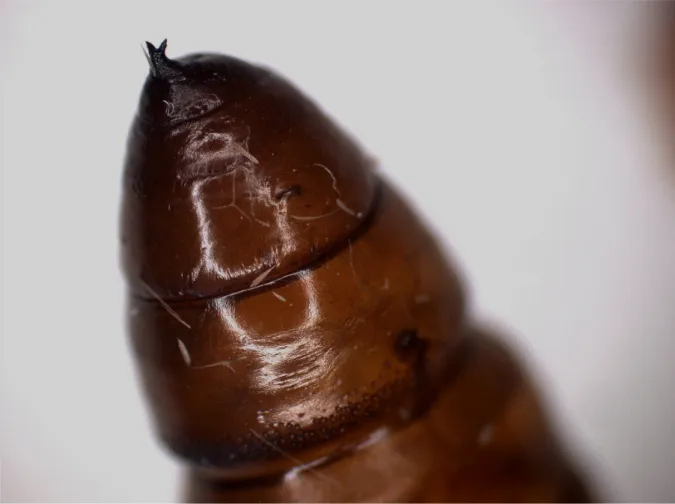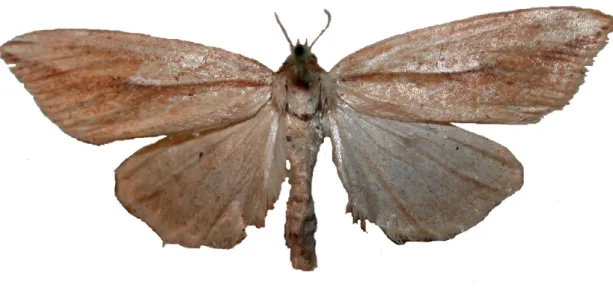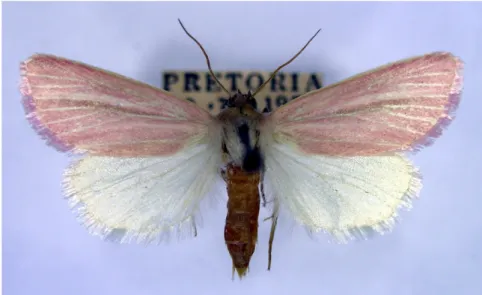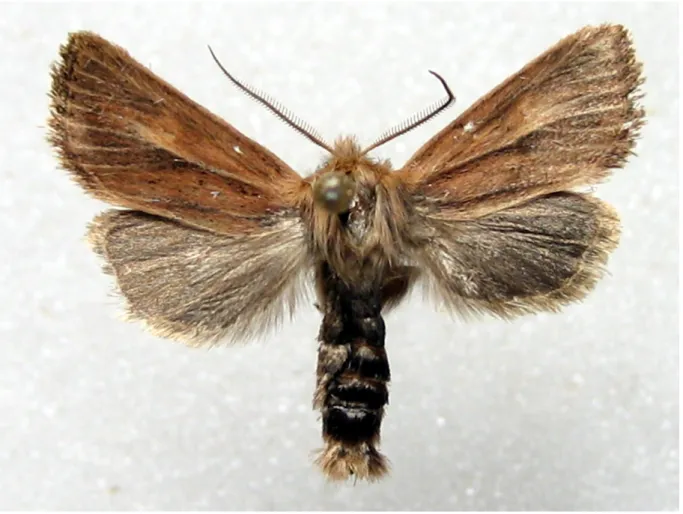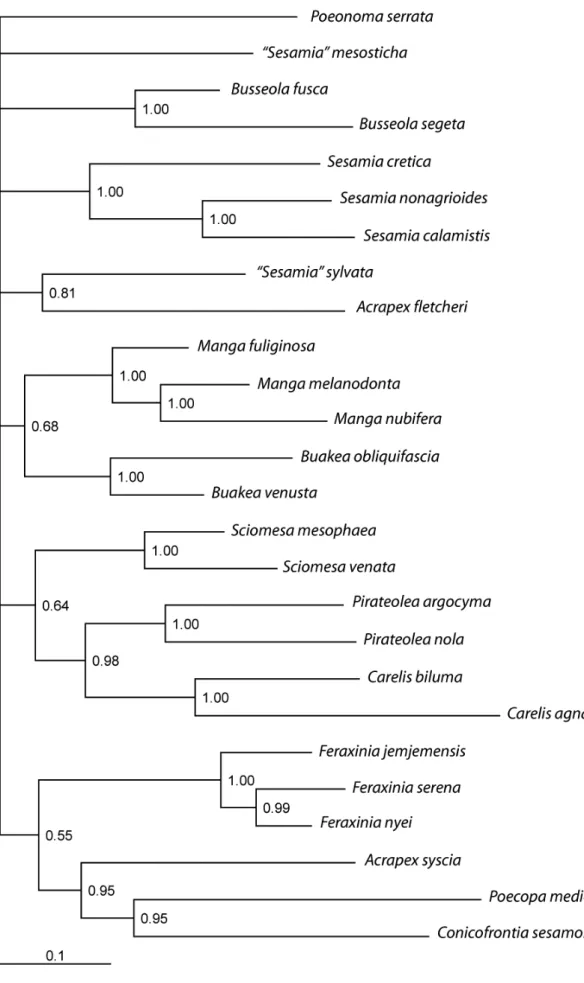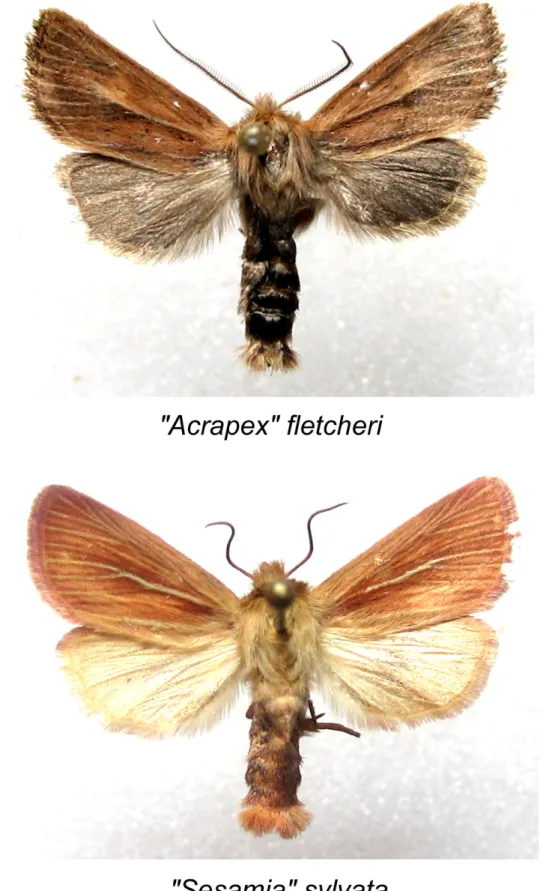HAL Id: hal-01226301
https://hal.archives-ouvertes.fr/hal-01226301
Preprint submitted on 9 Nov 2015HAL is a multi-disciplinary open access archive for the deposit and dissemination of sci-entific research documents, whether they are pub-lished or not. The documents may come from teaching and research institutions in France or abroad, or from public or private research centers.
L’archive ouverte pluridisciplinaire HAL, est destinée au dépôt et à la diffusion de documents scientifiques de niveau recherche, publiés ou non, émanant des établissements d’enseignement et de recherche français ou étrangers, des laboratoires publics ou privés.
Is Acrapex fletcheri Laporte really an Acrapex
(Lepidoptera : Noctuidae)?
Pascal Moyal
To cite this version:
Pascal Moyal. Is Acrapex fletcheri Laporte really an Acrapex (Lepidoptera : Noctuidae)?. 2015. �hal-01226301�
Is Acrapex fletcheri Laporte really an Acrapex (Lepidoptera :
Noctuidae)?
Pascal Moyal
IRD, 32 avenue Henri-Varagnat, 93140 Bondy, France. pascal.moyal@ird.fr
Abstract
This study shows that the species named Acrapex fletcheri Laporte does not belong to the genus Acrapex. This is clear from the adult morphology and the shape of the cremaster of the pupa. This is moreover confirmed by a Bayesian molecular phylogenetic analysis from two mitochondrial genes. In this analysis, A. fletcheri is the sister species of Sesamia sylvata Janse, a species that was proved in a previous study not to belong to the genus Sesamia but to a new genus that has to be described. Both species have similar habitus, but the deepness of the node of their branching as well as the different cremaster suggest they belong to two different genera, and that A. fletcheri should become the type species of another new genus. The genus Acrapex, represented by Acrapex syscia Fletcher in the analysis, is strongly connected to the genera Conicofrontia and Poecopa, which indicates common ancestry that is difficult to deduce from the rather different adult morphology of these species. However, these three genera have in common the absence of cremaster in the pupa. Another grouping, between the genera Buakea and Manga, is in accordance with the shape of the cremasters, but it is little supported (posterior probability=0.68). This phylogeny suggests that the ancestor of the African Sesamiina had likely a cremaster with two spines.
Introduction
The study on the cremasters of the pupae of Sesamiina (1) showed that, except for
Pirateolea, this structure was characteristic of the genus. The pupa of Acrapex fletcheri
Laporte has a peculiar bifid cremaster (figure 1), different from that of the other species of Sesamiina, including other Acrapex, such as Acrapex syscia Fletcher and the close species
Acrapex brunnea Hampson, who have no cremaster (1). This suggests that A. fletcheri might
not belong to the genus Acrapex or to any other known genus of Sesamiina.
This study aims at presenting the genus Acrapex and at checking, using morphological and molecular data, if A. fletcheri is really an Acrapex.
Figure 1. Cremaster of the pupa of Acrapex fletcheri Laporte.
Materials and Methods
Larvae of the studied stem borers were collected within their host plants in East Africa and southern Africa. They were reared on artificial diet (2) until pupation and the species were identified after emergence of the adults. The specimens of A. fletcheri were collected in the same place as the type described by Laporte (3), Mau escarpment, in Kenya. The pictures or slides of the types were obtained from museums (London, Paris, Pretoria).
Sequence data were obtained from fragments of two mitochondrial genes, Cytochrome
b (Cytb) (915 nucleotides), Cytochrome c Oxidase, subunit 1 (CO1) (892 nucleotides), Total
DNA was extracted using a Qiagen DNeasy tissue kit (Qiagen GmbH, Germany).The PCR rofile for the genes was : initial denaturation for 5 min at 92 °C; 35 cycles of denaturation for 1 min at 92 °C, annealing for 1.30 min at 46 °C, extension for 1.30 min at 72 °C; and final extension for 5 min at 72 °C. The reaction mixture contained 3 mM MgCl2, 0.4 µM primers, 0.24 µM dNTPs, 2 U of Promega Taq polymerase and 100 ng of DNA per 50 µl of reaction mixture. The primers used were : for cytb, CP1 (5’-GATGATGAAATTTTGGATC-3’) (modified from (4)) and TRs (5’-TCT ATCTTATGTTTTCAAAAG-3’) (10) ; for CO1, Ron
(5’-GGATCACCTGATATAGCATTCCC-3’) and Hobbes
(5’-AAATGTTGNGGRAAAAATGTTA-3’) (5). The PCR product was then purified using the Qiagen QIAquick PCR purification kit (Qiagen GmbH, Germany). Sequencing reactions were
carried out using the Sanger dideoxy method (6), and, finally, sequences were run and detected on an ABI 377 automated séquencer.
The sequences were aligned with Multalin software (7). The nucleotide substitution model used was GTR with proportion of invariable sites and gamma distribution. Phylogenies were inferred using a Bayesian method carried out using MrBayes 3.1 (8).
Results and discussion
1- The genus AcrapexThe genus Acrapex was created by Hampson in 1894. The type species is Acrapex
prisca, from India (figure 2).
Figure 2. Acrapex prisca Hampson: type of the species and of the genus Acrapex. In his major work of 1910 (9), Hampson described six new species of Acrapex and the other nine species already included in the genus, and defined again the genus. In particular, he mentioned two main features: « antennae of male typically ciliated » and « Forewing with the apex produced and acute, the termen obliquely curved and not crenulated ». He gave an identification key based on the male antennae (biserrate and fasciculate, with quadrate uniserrations, annulated and ciliated). Only the adult habitus was used at the time to classify the species.
In 1939, Janse (10) gave a new definition of the genus based on the species Acrapex
aenigma Felder & Rogenhofer, of which he had specimens (figure 3). He described precisely
the habitus, and, for the first time in the genus, the male genitalia. He told that 17 species had already been described in the genus, among which 14 are African and eight found in South Africa. He described five new species. Therefore, at this time, the species number in the genus amounted to 22.
Figure 3. Acrapex aenigma Felder & Rogenhofer. A. Male adult. B. Male genitalia.
In 1967, Viette (11) reported four species in Madagascar, among which two were new. He gave a full description of the genus, which included the habitus and the male and female genitalia. According to him, the antennae are typically ciliated in the males and the forewings have a pointed apex and an exterior margin regularly curved.
The new species described by Viette are very close to the species typical of the genus, which were described by Hampson and Janse. Likewise, his definition of the genus genitalia is that of the classical species. Nevertheless, Janse (10) had placed previously in the genus several species whose genitalia were noticeably different from Viette’s description. He mentioned it in his description of Acrapex mystica, where he told that the genitalia in the genus Acrapex fall into three groups.
Berio (12) was faced with this diversity when he studied 16 species he placed in the genus Acrapex. He explained he had no possibility to observe the types and that he was not absolutely certain that some of the species he described were different from species that were previously described. Their genitalia were close to those of species described by Janse, but their habitus was very different. He decided therefore to describe these species as new ones until someone can check whether they are synonymous or not. Moreover, he added a fourth group to the three groups of genitalia described by Janse, because none of the pictures of the latter seemed to correspond to these genitalia.
Following Berio, Laporte (3) placed many new species in the genus Acrapex, among which several would be misplaced according to Holloway (8). In my study on the genera
Sciomesa and Carelis (14), I transferred one of these species in Sciomesa (Acrapex boulardi
Laporte became Sciomesa boulardi) and I identified four cases of synonymy: Acrapex
congitae Laporte synonymous with Sciomesa boulardi; Acrapex sparsipuncta Laporte
synonymous with Sciomesa excelsa (Laporte); Acrapex bryae Laporte and Acrapex fayei Laporte synonymous with Feraxinia jemjemensis (Laporte).
The genus Acrapex appears then still confused: some of the species described by Berio may be synonymous with species described by Janse; the genitalia diversity raises the question of the limits of the genus; many species considered as different by Laporte might be synonymous. The revision of the genus using molecular data would be of great interest. I will limit myself hereinafter to the case of Acrapex fletcheri Laporte.
2- Acrapex fletcheri Laporte
The species type was collected in Kenya, in Mau-escarpment, in 1975 (3). It is shown in figure 4. As it is in rather bad condition, I show, in figure 5, a specimen obtained from a larva collected in its host plant in the same place.
Figure 5. Acrapex fletcheri: male obtained from larva.
This species is more robust and stockier than the typical Acrapex such as those shown in figures 1 and 2. Its forewings are less oblong. Moreover, its antennae are strongly bipectinate, whereas, according to Hampson, Janse and Viette, the antennae of Acrapex are either ciliated without serration or serrate. Its male genitalia are also different from those of the other Acrapex, with the presence of a clasper, and a long and thin cucullus versus a broad, short and rounded one in the other species.
The morphological features of the adult, as well as the cremaster of the pupa, suggest therefore that this species does not belong to the genus Acrapex.
The phylogenetic tree that resulted from the analysis of the molecular data is shown in figure 6.
Figure 6. Phylogenetic tree resulting from the bayesian analysis of the two mitochondrial genes. Numbers indicate Bayesian posterior probabilities. The quotation marks
This tree shows that the species called Acrapex fletcheri has no recent common ancestor with the species typical of the genus, Acrapex syscia, but is the sister of a species misplaced in the genus Sesamia, S. sylvata. This group is rather well supported (posterior probability=0.81). The deep node and the long branches as well as the different cremasters suggest that both species belong to two different genera that have to be created. The likeness of the habitus of the adults (figure 7) suggests that both genera should make up a monophyletic genus group.
Figure 7. Habitus of the two sister species in the molecular phylogeny. The quotation marks indicate that the species is misplaced in the genus.
Furthermore, the phylogenetic tree shows that the genus Acrapex, represented by A.
syscia, is strongly connected to a group made up of the genera Conicofrontia and Poecopa
(posterior probability=0.95). Yet, the morphology of the adults of these species looks rather different, from the frail Acrapex to the robust Conicofrontia. But they share in common the absence of cremaster in the pupa (1). Another grouping, between Buakea and Manga, although much less supported (posterior probability=0.68), is in line with the shape of the cremaster.
This phylogeny shows therefore that the species called Acrapex fletcheri does not belong to the genus Acrapex and should become the type species of a new genus. It shows also that most genus groups have at least one genus whose pupa has a cremaster with two spines, which suggests that the ancestor of the African Sesamiina had such cremaster. The absence of cremaster seems to be a more recent and secondary character, which is ancestral in the group Acrapex-Conicofrontia-Poecopa, whereas, regarding the Sciomesa genus group and perhaps Poeonoma serrata, it would result from an evolutionary convergence.
References
1- P. Moyal. African Sesamiina (Lepidoptera: Noctuidae): the cremaster and the genus. Hal-01223878.
2- F.O. Onyango & J.P.R. Ochieng’Odero, 1994. Continuous rearing of the maize stem borer Busseola fusca on an artificial diet. Entomologia Experimentalis
et Applicata, 73: 139–144.
3- B. Laporte, 1984. Noctuidae. p. 12-51 in: Rougeot P. C. (ed.), Missions entomologiques en Ethiopie 1976-1982. Mémoires du Museum national d‘Histoire naturelle (Nouvelle série). Volume 128, Fascicule II. Museum National d’Histoire Naturelle, Paris.
4- M. Harry, M. Solignac & D. Lachaise, 1998. Molecular evidence for parallel evolution of adaptative syndromes in fig-breeding Lissocephala (Drosophilidae). Molecular Phylogenetics and Evolution, 9: 542–551.
5-‐ A. Monteiro & N.E. Pierce, 2001. Phylogeny of Bicyclus (Lepidoptera: Nymphalidae) inferred from COI, COII, and EF-‐1alpha gene sequences. Molecular Phylogenetics and Evolution, 18: 264 – 281.
6-‐ F. Sanger, S. Nicklen & A.R. Coulson, 1977. DNA sequencing with chain-‐terminating inhibitors. Proceedings of the National Academy of Sciences, 74: 5413–5467.
7-‐ F. Corpet, 1988. Multiple sequence alignment with hierarchical clustering. Nucleic Acids Research, 16: 10881–10890.
8-‐ F. Ronquist & J.P. Huelsenbeck, 2003. MRBAYES 3: Bayesian phylogenetic inference under mixed models. Bioinformatics, 19: 1572–1574.
9- G.F. Hampson, 1910. Catalogue of the Noctuidae in the Collection of
the British Museum. Taylor & Francis, London, 552 p.
10- A.J.T. Janse, 1939. The Moths of South Africa. p. 307-435, Volume 3. Cymatophoridae, Callidulidae and Noctuidae (partim). E.P. & Commercial Printing Co. Ltd, Durban.
11- P. Viette, 1967. Insectes Lépidoptères Noctuidae Amphipyrinae (Part.)
12- E. Berio, 1973. Nuove species e generi di noctuidae africane e asiatische e note sinonimiche. Parte II. Annali del museo civico di storia naturale „Giacomo doria” 79: 126-171.
13- J.D. Holloway, 1998. Noctuidae. p. 79-86 in: Polaszek A. (ed.), African Cereal Stem Borers. CABI, London.
14- P. Moyal, B. Le Rü, D. Conlong, D. Cugala, B. Defabachew, T. Matama-Kauma, B. Pallangyo & J. Van den Berg, 2010. Systematics and molecular phylogeny of two African stem borer genera, Sciomesa Tams & Bowden and Carelis Bowden (Lepidoptera: Noctuidae). Bulletin of Entomological Research, 100: 641-659.
